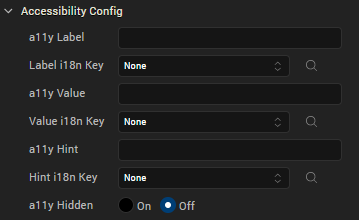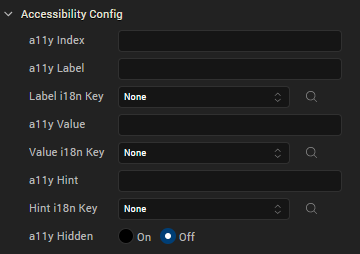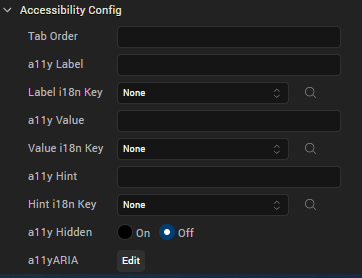Enable Accessibility in Visualizer
Quantum Visualizer provides accessibility features to support all the above principles for support to assistive technology, for its widgets and components to be compliant with WCAG 2.0. WCAG 2.0 compliance is not a framework compliance but it applies to the applications designed & developed using the framework. The framework enables (through its features) app design & development to follow this standard. The application design and development requirements would need to adhere to the WCAG 2.0 guidelines while developing the application. This along with the features that the platform exposes would ensure compliance to WCAG 2.0.
The built-in assistive technology in the iOS and Android platforms reads some basic widgets of Quantum Visualizer, such as Button, Label, and TextBox. The assistive technology in iOS and Android platforms read the information differently on other widgets.
Every application that is created using Quantum Visualizer is accessible to the built-in assistive technology of the iOS and Android platforms. The way the assistive technology interprets the widget information is left to its individual capability. Developers can enhance the behaviour of assistive technology with the configuration property (explained in the next page) available for each accessibility supported widget.
Configuring Accessibility
To define the Accessibility Config property for a widget from Quantum Visualizer, follow these steps:
- From the Default Library in Quantum Visualizer, drag a widget and drop it onto the canvas. For example, a Button widget.
- Select the Button widget and navigate to the Look tab of the Properties pane.
- Locate the Accessibility Config section, and enter the following values in the respective fields:
- a11yLabel: Specifies an alternate text to identify the widget. In general, the label must be the text that is displayed on the screen.
- a11yValue: Specifies the current state/ value associated with the widget so that the user can perform an action. For example, a checkbox is in selected state or unselected state.
- a11yHint: Specifies the descriptive text that explains the action about the widget.
- a11yHidden: Specifies if the widget must be ignored by assistive technology.
- a11yIndex: Specifies the order in which the widgets are focused on the screen while using the assistive technology. This field is applicable only for iOS native platform.
- Tab order:Specifies the order in which widgets must be focused in a form during navigation. It is linked to a11yARIA[“tabindex"] at runtime. This field is applicable for all channels except iOS.
From Quantum Visualizer V9 SP2 GA, you can enter the value of tab order as 0 and -1. Prior to V9 SP2, the developer could only set the value from 1. To set the tab order as 0 or -1, the developer had to define the values only through the code.
Tab Order Value Description 0 This value allows you to configure a non-focusable element to get focus, value also gives first priority to the widget on focus of a form during keyboard navigation. -1 No focus on a form during keyboard navigation. From the Quantum Visualizer V9 Service Pack 7 Fixpack 5 release, you can use the Tab Order property to set the focus on Segment rows and elements present within a Segment widget. Ensure that you set the View Type property of the Segment as either
TableorPage.Tab Order Value Focus on Parent Segment Focus on Segment Row Focus on element within the Segment Default No Yes Yes 0 (or more) Yes Yes Yes -1 No No Yes NOTE: If you set the View Type as Page, you can only set focus on the visible row and the child elements present within the visible row by using the Tab Order property. You cannot use the Tab key to focus on the next row when the View Type is set as Page.
- a11yARIA: Specifies the JSON object containing the key-value pairs that are added as the attribute and value to HTML tags respectively. These HTML tags provide the information to the assistive technologies such as screen readers. Any values provided for attributes such as
aria-labelledbyandaria-describedbyinside this field, takes precedence over values given ina11yLabelanda11yHintfields. This field is applicable only for Desktop Web platform.
The following image shows the Accessibility Config section in the Android platform.

The following image shows the Accessibility Config section in the iOS native platform.

The following image shows the Accessibility Config section in the Desktop Web platform.
NOTE: The Accessibility Config section appears on the Look tab only when the Accessibility Config check box is selected in the Project Settings > Application.
For Camera widget, when the capture mode is set to video, you will get additional options to record the video. The below keys are used to configure accessibility for the additional options:
- accessibilityConfigCaptureControl: Provides accessibility support to video capture button.
- accessibilityConfigTimerControl: Provides accessibility support to video timer button.
- accessibilityConfigSettingsControl: Provides accessibility support to video settings button.
- accessibilityConfigCancelControl: Provides accessibility support to video cancel button.
- accessibilityConfigVideoStartButton: Provides accessibility support to video start button.
- accessibilityConfigVideoStopButton: Provides accessibility support to video stop button.
accessibilityConfig Property
In order to support accessibility in Visualizer, a common property, accessibilityConfig is available in all widgets. This property enables you to control accessibility behavior and alternative text for the widget.
Syntax
accessibilityConfig = {
"a11yLabel" = "string value",
"a11yValue" = "string value",
"a11yHint" = "string value",
"a11yHidden" = true/false
}
Type
JSON Object
Read/Write
Read + Write
Remarks
The accessibilityConfig property is enabled for all the widgets which are supported under the Flex Layout.
NOTE: From Quantum Visualizer V9 SP2 GA version, you can provide i18n keys as values to all the attributes used inside the accessibilityConfig property. Values provided in the i18n keys take precedence over values provided in a11yLabel, a11yValue, and a11yHint fields.
The accessibilityConfig property is a JavaScript object which can contain the following key-value pairs.
| Key | Type | Description | ARIA Equivalent |
|---|---|---|---|
| a11yIndex | Integer with no floating or decimal number. | This is an optional parameter. Specifies the order in which the widgets are focused on a screen. | For all widgets, this parameter maps to the |
| a11yLabel | String | This is an optional parameter. Specifies alternate text to identify the widget. Generally the label should be the text that is displayed on the screen. | For all widgets, this parameter maps to the NOTE: For the Image widget, this parameter maps to the alt attribute of ARIA in HTML. |
| a11yValue | String | This is an optional parameter. Specifies the descriptive text that explains the action associated with the widget. On the Android platform, the text specified for a11yValue is prefixed to the a11yHint. | This parameter is similar to the a11yLabel parameter. If the a11yValue is defined, the value of a11yValue is appended to the value of a11yLabel. These values are separated by a space. |
| a11yHint | String | This is an optional parameter. Specifies the descriptive text that explains the action associated with the widget. On the Android platform, the text specified for a11yValue is prefixed to the a11yHint. | For all widgets, this parameter maps to the aria-describedby property of ARIA in HTML. |
| a11yHidden | Boolean | This is an optional parameter. Specifies if the widget should be ignored by assistive technology. The default option is set to false. This option is supported on iOS 5.0 and above, Android 4.1 and above, and SPA | For all widgets, this parameter maps to the aria-hidden property of ARIA in HTML. |
| a11yARIA | Object | This is an optional parameter. For each widget, the key and value provided in this object are added as the attribute and value of the HTML tags respectively. aria-labelledby and aria-describedby using this attribute, takes precedence over values given in a11yLabel and a11yHint fields.aria-labelledby and aria-describedby properties are used to set the IDs of the widgets that describe the value to be provided. You must provide only the widget IDs and not the widget path.Consider a Login scenario with a Label widget with the text Username and a TextBox widget for entering the username. To read the text in the Label widget when the TextBox widget is in focus, provide the id of the Label widget to the aria-labelledby property. When you want to provide a little more description for the value entered in the TextBox, you can provide the id of the widget with the description to the aria-describedby property. NOTE: When a widget is provided with the following key value pair or attribute using the a11yARIA object, the tabIndex of the widget is automatically appended as zero: | This parameter is only available on the Desktop Web platform. |
| tagName | String |
| This parameter is only available on the Responsive Web (Desktop Web) platform. |
| a11yAttributes | Array |
| This parameter is only available on the Android and iOS Native platforms. |
| a11yChildrenHidden | Boolean |
| This parameter is only available on the Android and iOS Native platforms. |
Accessibility in Components
- In a FlexForm containing direct widgets and components, while providing values to the
aria-labelledbyand thearia-describedbyproperties for widgets directly inside the FlexForm, you must not provide the Id of the widgets inside the components. - In a component containing direct widgets and child components, while providing values to the
aria-labelledbyand thearia-describedbyproperties for widgets directly inside the component, you must not provide the Id of the widgets inside the child components.
Android limitations
- If the results of the concatenation of a11y fields result in an empty string, then accessibilityConfig is ignored and the text that is on widget is read out.
- The soft keypad does not gain accessibility focus during the right/left swipe gesture when the keypad appears.
- The i18n key support in
accessibilityConfigproperty depends on the languages supported by the TTS(Text-To-Speech) engine of the mobile device. If the TTS engine of the mobile device does not support a language, the text provided in theaccessibilityConfigproperty is not read by the TTS engine.
SPA/ Desktop Web limitations
- To use the
accessibilityConfigproperty on the Desktop Web platform, ensure that you disable the Legacy JS Mode in theProject Settings > Responsive Websection. - When
accessibilityConfigproperty is configured for any widget, thetabIndexattribute is added automatically to theaccessibilityConfigproperty. - The behavior of accessibility depends on the Web browser, Web browser version, Voice Over Assistant, and Voice Over Assistant version.
- Currently SPA/Desktop web applications support only a few ARIA tags. To achieve more accessibility features, use the attribute a11yARIA. The corresponding tags will be added to the DOM as per these configurations.
- The tagName attribute supports the following tags in Label, Segment, FlexContainer, and FlexScrollContainer widgets.
Example 1
This example uses the Login scenario to explain how to provide accessibility to the usernameText TextBox widget inside the frmLogin Form. The frmLogin form also contains the usernameLbl Label widget (with the text Username) and rulesLbl Label widget(that contains the username policies).
//This is a generic property that is applicable for various widgets.
/*Here, we have shown how to use the accessibilityConfig Property for a TextBox widget.You need to make a corresponding use of the accessibilityConfig property for other applicable widgets.*/
frmLogin.usernameText.accessibilityConfig = {
"a11yLabel": "Label",
"a11yValue": "Value",
"a11yHint": "Hint",
"a11yARIA": {
"tabindex" /* Integer with no floating/decimal numbers*/: 1,
"role" /*Prescribed string value as per wcag guidelines*/: "main",
"aria-labelledby": "usernameLbl"
"aria-describedby": "rulesLbl"
}
};Example 3
This example uses the button widget to implement internationalization in accessibilityConfig property, but the principle remains the same for all widgets.
/*Sample code to implement internationalization in accessibilityConfig property in Native platform.*/
Form1.myButton.accessibilityConfig = {
"a11yLabel": kony.i18n.getLocalizedString("key1")
};
/*Sample code to implement internationalization in accessibilityConfig property in Desktop Web platform.*/
Form1.myButton.accessibilityConfig = {
"a11yLabel": "kony.i18n.getLocalizedString(\"key3\")"
};Platform Availability
- Available in the IDE
- iOS, Android, SPA, and Desktop Web

